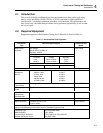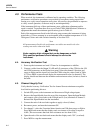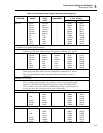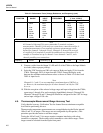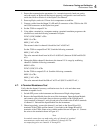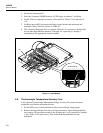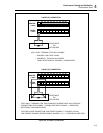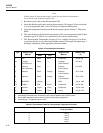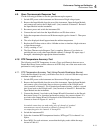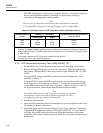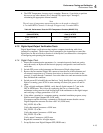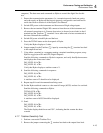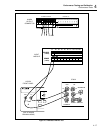
HYDRA
Service Manual
4-10
Note
If other than a K type thermocouple is used, be sure that the instrument is
set up for the type of thermocouple used.
3. Reconnect power and switch the instrument ON.
4. Insert the thermocouple and a mercury thermometer (.02 degrees Celsius resolution)
in a room temperature bath. Allow 20 minutes for thermal stabilization.
5. Select the temperature function and K thermocouple type for channel 1. Then press
MON.
6. The value displayed should be the temperature of the room temperature bath (within
tolerances given in Table 4-4) as measured by the mercury thermometer.
7. The Thermocouple Temperature Accuracy Test is complete. However if you desire
to perform this test on any other Input Module channel (2 through 20) repeat steps 1
through 6 substituting in the appropriate channel number.
Table 4-3. Thermocouple Information
Type Positive Lead
Positive Lead Color
Negative Lead Usable Range
Material
ANSI* IEC**
Material (°C)
J Iron White Black Constantan -200 to 760
C† Tungsten
(5% Rhenium)
White — Tungsten
(26% Rhenium)
0 to 2316
b Platinum
(30% Rhodium)
Gray — Platinum
(6% Rhodium)
0 to 1820
S Platinum Black Orange Platinum
(10% Rhodium)
-50 to 1768
R Platinum Black Orange Platinum
(13% Rhodium)
-50 to 1768
N NICROSIL Orange — NISIL -270 to 1300
T‡ Copper Blue Brown Constantan -270 to 400
E Chromel Purple Violet Constantan -270 to 1000
K Chromel Yellow Green Alumel -270 to 1372
* American National Standards Institute (ANSI) device negative lead is always red.
** International Electrotechnical Commission (IEC) device negative lead is always white.
† Not an ANSI designation but a Hoskins Engineering Company designation.
‡ An ANSI type T is supplied with the meter.
Table 4-4. Performance Tests for Thermocouple Temperature Function
Thermocouple Type Themocouple Temperature Function
1 Year @ 18-28°C
J
K
N
E
T
± 0.4°C
± 0.5°C
± 0.6°C
± 0.4°C
± 0.5°C




